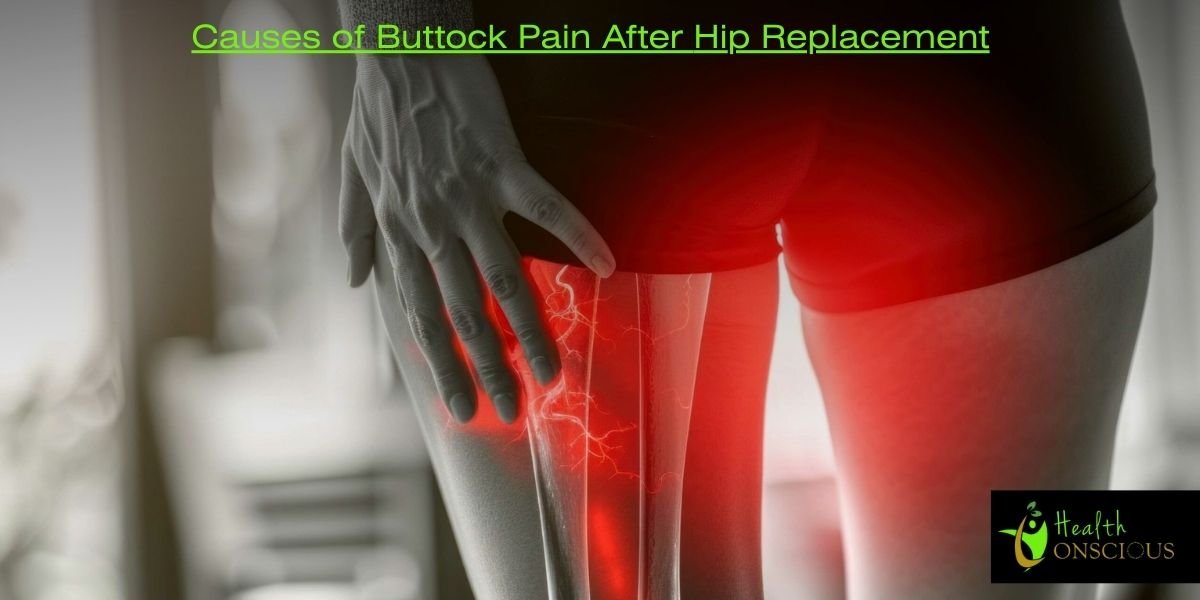Key Takeaways
- Buttock pain after a hip replacement is common and is caused by the hip’s anatomical connection to the gluteal muscles and sciatic nerve.
- Gluteal tendinopathy, or an injury to the buttock muscle tendons, is a frequent cause of chronic pain in this area.
- Deep Gluteal Syndrome (DGS) is a disorder in which the sciatic nerve becomes trapped, resulting in leg and buttock pain, tingling, or numbness.
- An MRI with special metal artifact reduction techniques is often the best way to diagnose soft tissue issues or implant problems.
- Physical therapy, lifestyle changes, and targeted medical care are the main treatments for most causes of buttock pain.
Understanding Buttock Pain After Hip Replacement
Hip replacement surgery is a life-changing procedure with a high success rate of over 90%, which helps to restore mobility and relieve chronic hip pain. You may feel pain during the recovery period, which is normal and indicates that your body is actively healing and adjusting to the changes. However, if the pain is too intense or lasts longer than expected, it may be a sign of an underlying problem that needs to be diagnosed.
In this article, you will learn about the common causes of buttock pain after hip replacement, key factors, and available treatment options. By exploring the specific causes, you can take control of your recovery and get back to feeling great. We also provide information on recovery activities to help you get back to a better life.
What Is the Connection Between Hips and Buttock Pain?
Your hips and buttocks are closely connected. The gluteal muscles form your buttocks and are vital for stabilizing the hip joint. The sciatic nerve also runs through this area. During surgery, these muscles and nerves are handled and stretched, which can lead to inflammation and pain in your buttocks as you heal.
Common Pains After Hip Replacement Surgery
After hip replacement surgery, some pain is normal. You’ll likely feel soreness around the incision, muscle spasms, and a dull ache in your hip and thigh. This is all part of the healing process. However, if your buttock pain is severe or doesn’t go away, it could be a sign of a more specific problem.
Causes of Buttock Pain After Hip Replacement
1. Gluteal Tendinopathy / Tendon Tears
This is a frequent cause of persistent buttock discomfort. The gluteal tendons, which connect your buttock muscles to your hip, can get irritated or even torn during or after surgery. This leads to persistent pain and weakness.
2. Deep Gluteal Syndrome
This happens when the sciatic nerve is compressed in the deeper buttock area. The signs often mimic sciatica, causing burning or sharp pain that can travel down the back of the leg. This can be caused by scar tissue or muscle spasms from the surgery.
3. Surgical Technique Complications
The way your surgeon accesses the hip joint can affect your recovery. For example, a posterolateral approach requires detaching and reattaching some muscles, which can cause post-operative pain and inflammation.
4. Hematoma Formation
A hematoma is a buildup of blood that may develop at the surgery site. This can put pressure on nearby nerves and soft tissues, causing pain, swelling, and stiffness in the buttock and hip.
5. Sciatic Nerve Irritation
The sciatic nerve is sensitive and can become irritated during surgery. Pulling on tissues to access the hip joint can cause temporary nerve inflammation. This can result in tingling, numbness, or a sharp pain that usually gets better over time.
6. Trochanteric or Ischial Bursitis
A bursa is a fluid-filled pouch that serves as a protective cushion. If the bursa on the side of your hip (trochanteric) or at the base of your buttock (ischial) becomes inflamed, it can cause localized pain and tenderness. This may occur when your walking style or gait changes following surgery.
7. Implant Loosening or Malpositioning
Although rare in the beginning, a loose or poorly positioned implant can cause friction and pressure on the surrounding tendons and nerves. This can lead to chronic, worsening pain during activities that involve weight.
8. Referred Pain From the Lower Back or Spine
Sometimes, leg and buttock pain isn’t from the hip itself. Problems in your lower back or sacroiliac (SI) joint can refer pain to the buttocks and hip. Since hip replacement surgery changes your posture, it can sometimes make a back issue worse.
9. Infection
This is a serious but uncommon complication. A joint infection can cause severe, lasting pain, often with a fever, redness, and warmth around the surgical site. If these symptoms appear, you should seek urgent medical care.
Risk Factors That Contribute to Pain
Several things can increase your risk of buttock pain after surgery:
- Pre-existing Conditions: If you had a history of back pain, piriformis syndrome, or gluteal tendinopathy before surgery, you’re more likely to have post-operative pain.
- Obesity: Carrying extra weight puts more stress on the hip joint and the soft tissues around it.
- Changes in Gait: Altered walking patterns after surgery can strain muscles that are not used to the new way of moving.
- Inadequate Rehabilitation: Not following your physical therapy plan can lead to muscle weakness and improper healing.
Buttock Pain Diagnostic Approaches
To identify what’s causing your pain, a doctor will begin with a physical examination. They will assess your flexibility, muscle power, and the specific painful spot. If the discomfort continues, the next step is usually an MRI scan. While metal implants can make imaging tricky, special MRI techniques can help doctors see the soft tissues and identify issues like tendon tears or nerve compression that don’t show up on a standard X-ray.
When to Expect Pain vs. When to Call Your Doctor
A little pain is normal, but here’s when it may signal a problem. You should contact your surgeon or physical therapist if your buttock pain is:
- Severe and does not improve with rest or prescribed medicines.
- Accompanied by a fever, warmth, or redness.
- Causing numbness, weakness, or a shooting pain that goes down your leg.
- Getting progressively worse over time instead of better.
How to Prevent Buttock Pain After Hip Replacement
Prevention is all about preparing your body and following your recovery plan.
- Pre-operative Strengthening: Building strength in your core, hips, and gluteal muscles before surgery can help you recover faster.
- Follow Physical Therapy: Your physical therapist will assign you exercises to practice at home. The exercises are designed to restore muscle strength and enhance mobility.
- Modify Activities: Avoid high-impact activities, prolonged standing, or sitting on hard surfaces. Gradually increase your activity level as advised by your healthcare provider.
- Maintain a Healthy Weight: Losing extra weight can greatly reduce the stress on your hip joint.
Treatment Options for Buttock Pain After Hip Replacement
1. Physical Therapy and Rehabilitation
Physical therapy is the most important part of treatment. Your therapist will create a plan focused on stretching and strengthening exercises to improve muscle balance and flexibility around your hip. This helps ensure your new joint works as it should.
2. Lifestyle and Activity Modifications
Small changes can make a big difference. This includes using a cane for support, avoiding sitting with your legs crossed, and placing a pillow between your knees when you sleep on your side.
3. Medical Interventions and Pain Management
Over-the-counter anti-inflammatory medications like ibuprofen can help manage pain. In some cases, a doctor may suggest other interventions if conservative measures fail.
4. Non-Surgical Procedures
For persistent pain, a doctor may consider:
- Corticosteroid Injections: A steroid shot into the inflamed area can provide significant, though often temporary, relief.
- PRP Injections: Platelet-Rich Plasma therapy uses a concentrated solution from your own blood to stimulate healing in damaged tendons.
- Extracorporeal Shockwave Therapy (ESWT): This non-invasive treatment uses sound waves to help heal chronic tendon injuries.
5. Surgical Options (Revision Surgery)
In rare cases, if the pain is caused by a severely loose or poorly positioned implant, a second surgery (revision surgery) may be needed to fix the problem.
Rehabilitation and Recovery After Hip Replacement
1. Immediate Post-Operative Care
The first few weeks after surgery are crucial. You’ll manage pain with medication, use a walker or crutches as directed, and begin simple exercises to prevent stiffness.
2. Physical Therapy Regimen
Physical therapy usually begins within a few days of surgery. Sessions focus on restoring your range of motion, strengthening muscles around the hip, and improving your walking pattern.
3. Home Exercise Program
Your therapist will provide you with home-based exercises to perform. Being consistent with these exercises is key to building strength, improving flexibility, and reducing the risk of muscle imbalances.
4. Long-Term Recovery and Activity Guidelines
It can take up to a year to fully recover. In the long term, you should continue with a low-impact exercise routine like walking, swimming, or cycling to keep your hip strong and mobile. Avoid high-impact activities like running unless your doctor approves.
Conclusion
Buttock pain after a hip replacement is a real and common issue that should not be ignored. While some discomfort is part of the healing process, persistent or worsening pain can be a sign of underlying problems, most often related to irritated tendons or nerves. With a proper diagnosis, physical therapy, and a proactive approach to managing symptoms, most people can successfully address the pain and get back to their daily lives.
Disclaimer
The content in this article is intended solely for informational use. It is not a substitute for professional medical advice, diagnosis, or treatment. Always talk to your doctor or a qualified healthcare provider if you have any questions about a medical condition.
Authentic Sources & References
- Regenexx. Pain After Hip Replacement. Retrieved from https://regenexx.com/blog/pain-after-hip-replacement/
- Cleveland Clinic. Gluteal Tendinopathy: Symptoms, Causes & Treatment. Retrieved from https://my.clevelandclinic.org/health/diseases/22960-gluteal-tendinopathy
- Cleveland Clinic. Trochanteric Bursitis: Symptoms, Causes & Treatments. Retrieved from https://my.clevelandclinic.org/health/diseases/4964-trochanteric-bursitis
- NIH – National Center for Biotechnology Information. Greater Trochanteric Pain Syndrome (Greater Trochanteric Bursitis). Retrieved from https://www.ncbi.nlm.nih.gov/books/NBK557433/
- American Academy of Orthopaedic Surgeons (AAOS). Hip Bursitis. OrthoInfo. Retrieved from https://orthoinfo.aaos.org/en/diseases–conditions/hip-bursitis/
- RadiologyInfo.org. Magnetic Resonance Imaging (MRI) of the Hip. Retrieved from https://www.radiologyinfo.org/en/info/mri-hip


